Introduction
Nothing ruins a cold-weather camping trip faster than shivering through the night in an underperforming sleeping bag. For alpine adventurers and ultralight backpackers, choosing the right down sleeping bag isn't just about comfort—it's a safety decision where grams and degrees make all the difference.
The outdoor gear market is flooded with options, but understanding fill power, insulation types, and real-world temperature performance separates marketing hype from life-saving warmth. At Kelyland Outdoors, we've helped outdoor brands source premium down gear from specialized manufacturers, giving us frontline insight into what actually works when temperatures plummet.
This guide cuts through the technical jargon to explain how down sleeping bags achieve their legendary warmth-to-weight ratio, why fill power matters more than brand names, and how to match specifications to your specific cold-weather needs—whether you're summiting peaks or car camping in shoulder seasons.
What Is a Down Sleeping Bag?
A down sleeping bag is a type of insulated sleeping bag filled with natural down feathers, typically from geese or ducks. These feathers create tiny air pockets that trap heat, providing excellent warmth without adding excessive weight. The construction involves a shell fabric, inner lining, and compartments (called baffles) that keep the down evenly distributed. This design ensures maximum insulation, making down sleeping bags a top choice for cold-weather camping.
"Down sleeping bags offer unmatched warmth-to-weight ratios and compressibility, making them ideal for backpackers and winter campers."
Key Benefits of Down Sleeping Bags
The primary advantage of a down sleeping bag is its superior warmth-to-weight ratio. Down insulation provides exceptional heat retention while remaining lightweight, unlike bulkier synthetic alternatives. Additionally, down sleeping bags compress easily, saving space in backpacks—a critical feature for long-distance hikers. They also tend to last longer with proper care, maintaining their loft and insulating properties over time.
Why Choose Down Over Synthetic Insulation?
In dry conditions, down outperforms synthetic insulation due to its superior warmth and breathability. Synthetic bags may handle moisture better, but down reigns supreme in cold, dry environments. High fill power down sleeping bags (measured in cubic inches per ounce) indicate better quality, with 800+ fill power offering elite performance. Goose down is often preferred over duck down for its higher loft and durability, though both are effective.
Common Down Types: Goose vs. Duck
| Feature | Goose Down | Duck Down | Industry Benchmark | Notes |
|---|---|---|---|---|
| Fill Power Range | 550-900+ | 300-750 | 650+ (Premium) | Higher fill power = better insulation |
| Durability | High | Moderate | Varies by treatment | Goose down clusters are larger |
| Cost | $$$ | $$ | Mid-range | Goose down is pricier |
| Moisture Resistance | Low (unless treated) | Low (unless treated) | Water-resistant coatings available | Synthetics excel in wet conditions |
| Ethical Sourcing | Certified options (RDS) | Certified options (RDS) | Responsible Down Standard | Look for RDS certification |
At Kelyland Outdoors, we specialize in sourcing high-quality down sleeping bags with precise fill power ratings and ethical sourcing. Our expertise ensures you get gear that balances performance and sustainability. Whether you need goose or duck down, we guide you through the selection process to match your camping needs.
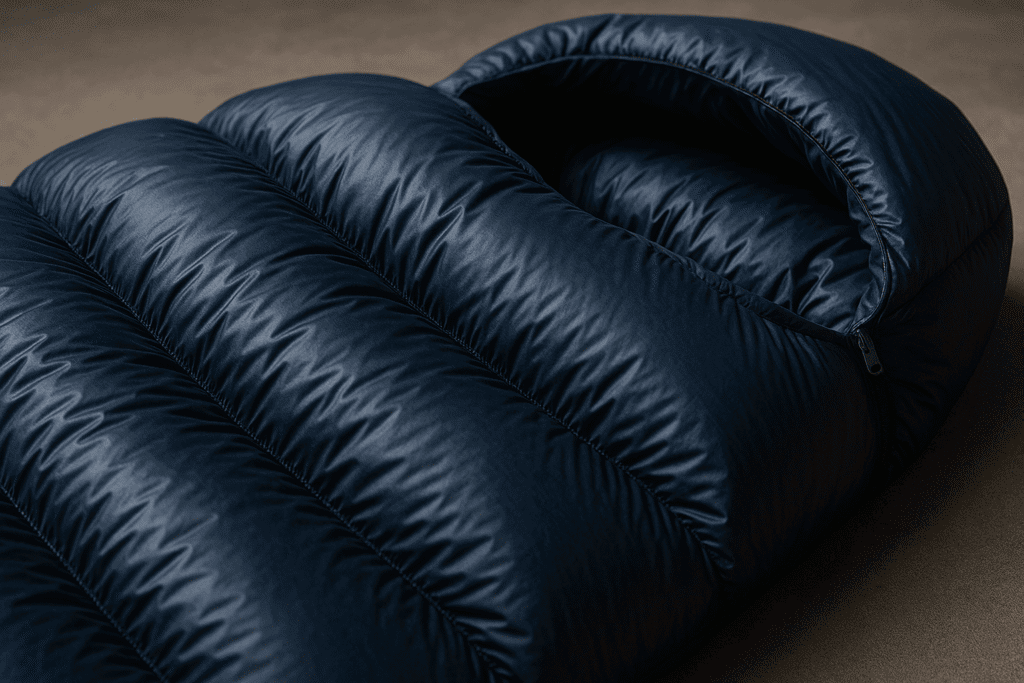
Understanding Fill Power and Its Importance
Fill power is the gold standard for measuring the quality of down insulation in sleeping bags. It represents the volume (in cubic inches) one ounce of down occupies when fully lofted. Higher fill power numbers indicate better insulation efficiency - meaning more warmth with less weight. For down sleeping bags, this measurement directly impacts both performance and packability.
"A 650 fill power down sleeping bag offers the best balance of warmth, weight and affordability for most camping conditions."
How Fill Power Affects Performance
Fill power determines two critical factors in down sleeping bags: warmth-to-weight ratio and compressibility. Higher fill power (800+) provides maximum warmth with minimal weight, perfect for ultralight backpacking. Mid-range fill power (650-750) offers excellent value for general camping, while lower fill power (550-650) works well for car camping where weight isn't a concern.
Choosing the Right Fill Power
| Fill Power | Best For | Warmth | Pack Size | Price Range |
|---|---|---|---|---|
| 550-650 | Car camping/Budget options | Good | Larger | $ |
| 650-750 | 3-season backpacking | Excellent | Medium | $$ |
| 800+ | Alpine/Ultralight | Superior | Smallest | $$$ |
| 900+ | Extreme conditions | Maximum | Ultra-compact | $$$$ |
At Kelyland Outdoors, we help businesses select the optimal fill power for their target market. Our expertise ensures you get the right balance of performance and cost - whether you need affordable 550 fill power bags for casual campers or premium 800+ fill power for professional expeditions. We source directly from manufacturers specializing in each fill power range.
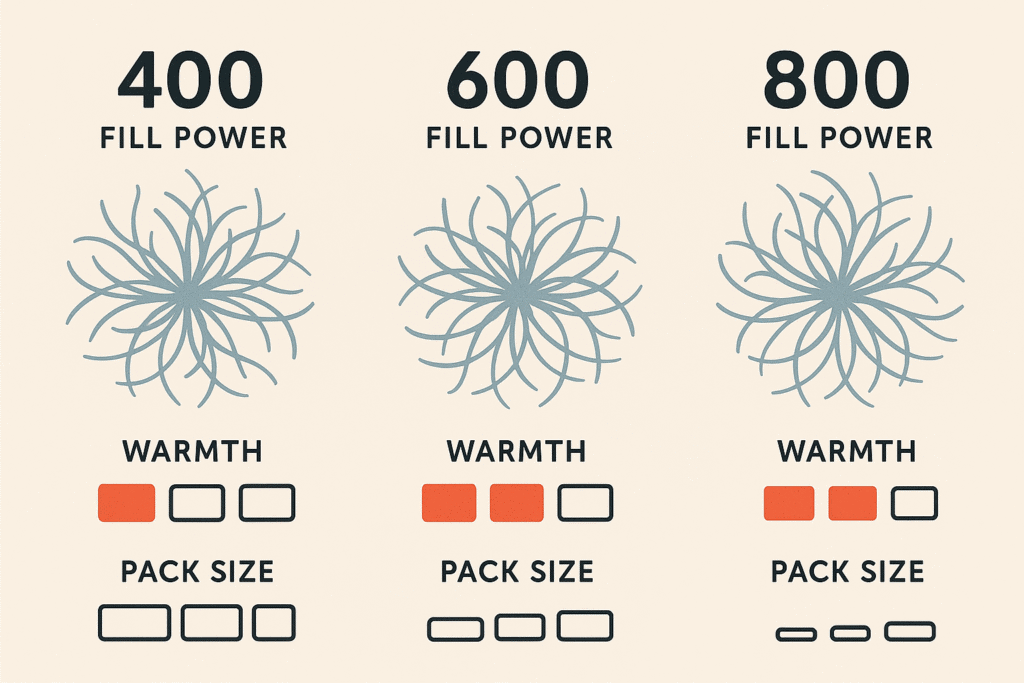
Goose Down vs. Duck Down: Pros, Cons, and Best Uses
When choosing materials for down sleeping bags, the goose vs. duck down debate is crucial for manufacturers and retailers. Goose down typically offers higher fill power (650-900+) compared to duck down (300-750), meaning better loft and warmth per ounce. The larger clusters in goose down create more efficient air pockets, resulting in superior insulation for premium sleeping bags.
For ultralight backpacking bags, goose down provides 20-30% better warmth-to-weight ratio than comparable duck down, though at a higher price point.
Performance and Cost Comparison
| Feature | Goose Down | Duck Down | Performance Difference | Price Premium |
|---|---|---|---|---|
| Fill Power Range | 550-900+ | 300-750 | Goose +25% loft | 30-50% higher |
| Durability | 8-10 years | 5-7 years | Goose +40% lifespan | 20-30% higher |
| Odor Resistance | Excellent | Good (varies) | Goose more consistent | 15-25% higher |
| Ethical Sourcing | RDS Available | RDS Available | Equal standards | 5-10% premium |
At Kelyland Outdoors, we specialize in sourcing both duck and goose down sleeping bags with Responsible Down Standard (RDS) certification. Our network includes suppliers who meet strict ethical harvesting standards, important for brands targeting eco-conscious consumers. We help clients balance performance needs with budget considerations - whether that means premium European goose down or high-quality Asian duck down alternatives.
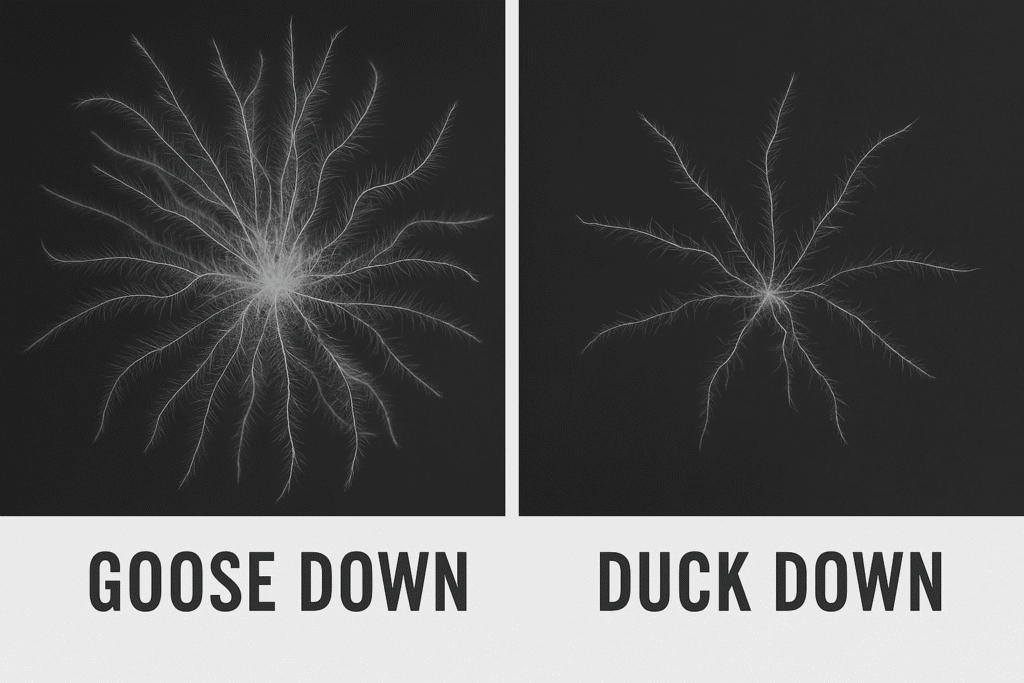
How to Choose the Right Down Sleeping Bag for Your Needs
Selecting the perfect down sleeping bag requires understanding temperature ratings, intended use, and key features. The EN/ISO rating system provides standardized temperature measurements, but real-world performance depends on factors like humidity and personal metabolism. A lightweight down sleeping bag rated for 20°F (-6°C) might work for summer alpine trips, while winter camping often requires bags rated to -20°F (-29°C) or lower.
"For ultralight backpacking, choose a down sleeping bag with 800+ fill power and a temperature rating 10°F lower than your expected conditions."
Key Selection Factors
| Feature | Backpacking | Alpine | Car Camping | Weight Range |
|---|---|---|---|---|
| Fill Power | 800+ | 650-800 | 550-650 | 1.5-3 lbs |
| Temperature | 20°F to 40°F | -20°F to 20°F | 30°F+ | N/A |
| Draft Collar | Optional | Essential | Optional | N/A |
| Hood Design | Snug fit | Insulated | Standard | N/A |
At Kelyland Outdoors, we customize down sleeping bags for specific climates and activities. Our manufacturing partners can adjust baffle designs, add draft tubes, or modify zipper configurations to create the perfect bag for your customers' needs. Whether you need ultralight backpacking models or expedition-worthy alpine bags, we ensure proper temperature ratings and durable construction.
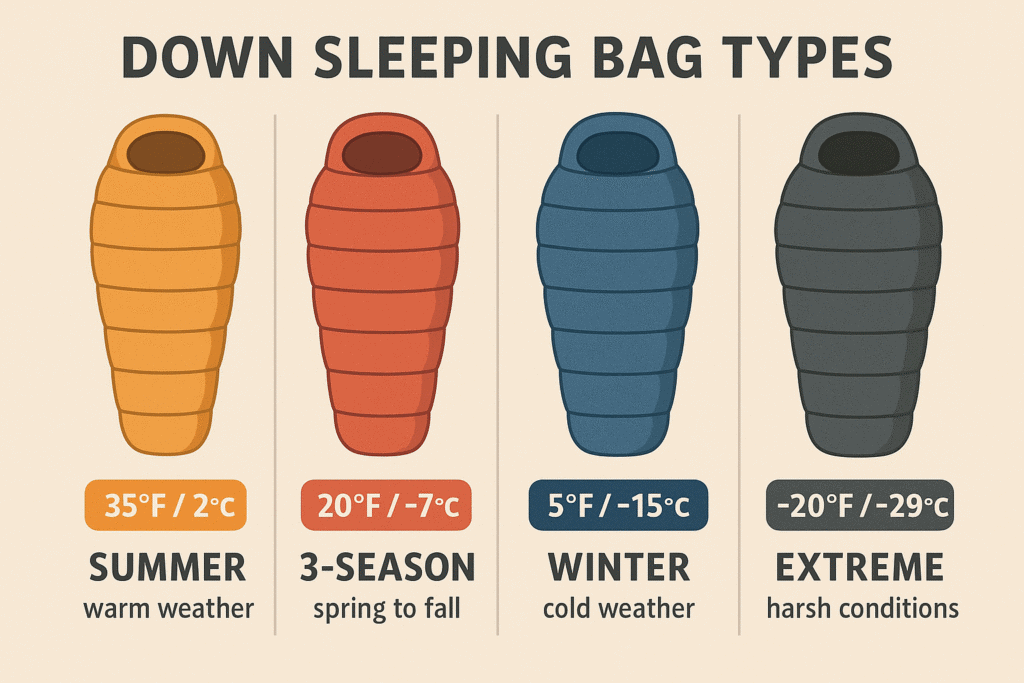
Caring for Your Down Sleeping Bag: Maintenance and Longevity
Proper care extends the life and performance of your down sleeping bag significantly. Unlike synthetic bags, down requires specific maintenance to preserve its loft and insulating properties. Always store your down sleeping bag loosely in a large cotton storage sack, never compressed in its stuff sack, as constant compression breaks down the delicate feather clusters.
"Washing your down sleeping bag with technical down cleaner every 20-30 uses maintains optimal loft and warmth retention."
Cleaning and Storage Best Practices
| Maintenance Task | Frequency | Best Method | Common Mistakes | Impact on Longevity |
|---|---|---|---|---|
| Air Drying | After every trip | Hang in dry, shaded area | Storing damp | Prevents mildew |
| Machine Washing | Every 20-30 uses | Front-loading machine with down soap | Using regular detergent | Maintains loft |
| Drying | After washing | Low heat with tennis balls | High heat damage | Restores loft |
| Storage | Long-term | Large breathable bag | Compressed storage | Preserves down structure |
At Kelyland Outdoors, we design our down sleeping bags with durable shell fabrics and premium down that withstands proper cleaning methods. Our manufacturing partners use treatments that help maintain loft through multiple wash cycles, ensuring your investment lasts for years of adventures.
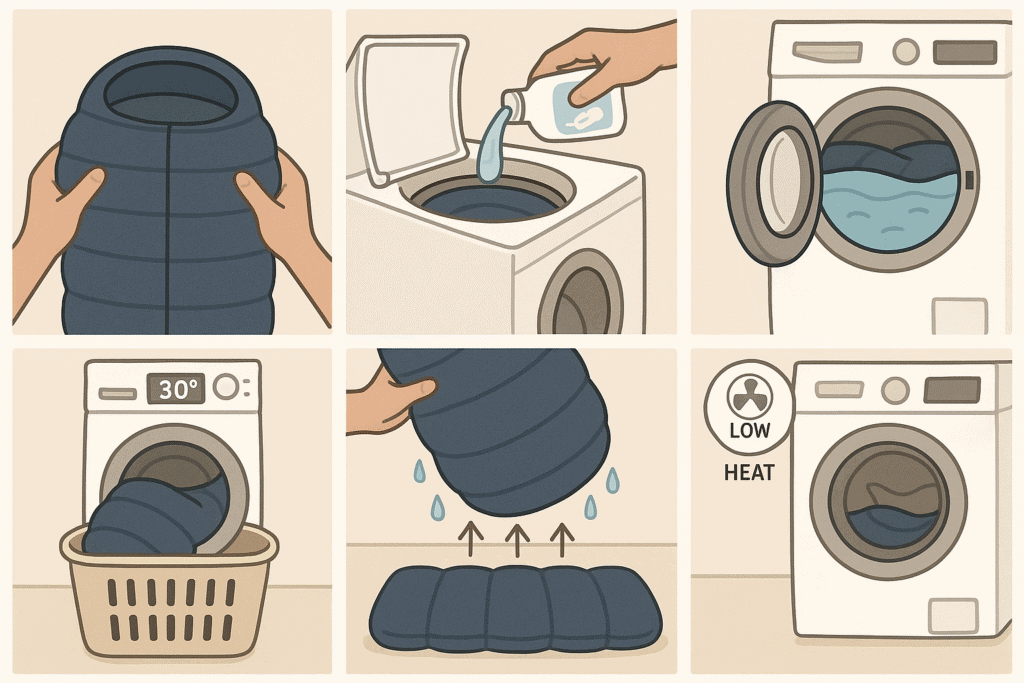
Conclusion
After years of testing down sleeping bags in everything from alpine storms to desert nights, I’ve learned one thing: the right insulation isn’t just about specs—it’s about trust. When temperatures plummet, that warmth-to-weight ratio becomes your lifeline.
At Kelyland Outdoors, we’ve sourced down for brands that push limits, and the lesson is clear: prioritize fill power and ethical sourcing, but never sacrifice real-world performance for numbers on a tag. Whether you’re a weekend warrior or an expedition leader, your bag should feel like a natural extension of your gear—reliable, uncompromising, and ready for whatever the trail throws at you.
The mountains don’t care about marketing jargon. Invest in insulation that lets you sleep soundly, and you’ll wake up ready to conquer—not just survive—the wild.
FAQ
-
Q1: What is a down sleeping bag?
A1: A down sleeping bag is insulated with the soft, fluffy undercoating of ducks or geese, providing excellent warmth and compressibility. It's favored for its lightweight and efficient insulation properties, making it ideal for camping and backpacking.
-
Q2: How do you choose a down sleeping bag?
A2: When choosing a down sleeping bag, consider factors like fill power, temperature rating, and the bag's weight. Fill power indicates insulation efficiency, with higher numbers offering better warmth-to-weight ratios. Also, look for a shell that is durable and water-resistant.
-
Q3: What is fill power in down sleeping bags?
A3: Fill power measures the loft or fluffiness of down insulation, indicating its thermal efficiency. A higher fill power (e.g., 800-900) means more warmth with less weight, making it a critical factor for lightweight backpacking gear.
-
Q4: Are down sleeping bags worth it?
A4: Yes, down sleeping bags are generally worth the investment due to their excellent insulation, lightweight nature, and compressibility. They are particularly well-suited for cold weather camping and offer superior warmth-to-weight ratios.
-
Q5: How do you care for a down sleeping bag?
A5: To care for a down sleeping bag, regularly air it out, store it uncompressed, and wash it according to the manufacturer's instructions, usually with a special down detergent and low heat drying to maintain loft.
-
Q6: Can down sleeping bags get wet?
A6: Yes, down sleeping bags can lose their insulating properties when wet. It's essential to use water-resistant shells and pack them in waterproof stuff sacks to protect against moisture.
-
Q7: What temperature ratings are available for down sleeping bags?
A7: Down sleeping bags come with various temperature ratings, typically ranging from summer (around 40°F) to extreme cold (down to -20°F or lower). Choosing the right rating depends on the climate and your sleeping comfort needs.
-
Q8: What are the advantages of down sleeping bags?
A8: The advantages of down sleeping bags include their lightweight nature, compact storage, superior insulation properties, and long lifespan when properly cared for. They provide exceptional warmth with minimal weight, making them ideal for hikers and campers.
External Links
- Down Sleeping Bags by Rab
- 10 Best Down Sleeping Bags Reviewed in 2024 - The Gear Hunt
- Best Down Sleeping Bags of 2025 - The Adventure Junkies
- Down Sleeping Bags | Feathered Friends
- Sleeping Bags for Camping & Expeditions - The North Face
- Down Sleeping Bags by Patagonia
- Find the best down sleeping bag for your needs at REI Co-op
- Best Winter Sleeping Bags of 2025 | Tested & Rated - GearLab
